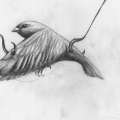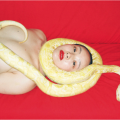‘Come doused in mud, soaked in bleach, as I want you to be, as a friend, as a trend, as an old memoria, memoria, memoria. ’Kurt Cobain Art often deals with the interaction of memory with everyday life. It is not by chance that this is also the subject of a song considered a manifesto of the 90’s. ’Come As You Are’ by Nirvana talks about the fear of not being accepted, that frustrates the post 80’s young Americans. Cobain’s words explain well the feelings of fear, anger and discomfort of a teenager who lives in a society that is progressively losing memories and values once shared. The repetition Come as you are seems like an order to bring identity that is anchored in one’s individual past; almost a weapon for fighting conformism. The words of ’Come As You Are’ seem to echo in the work of the Italian artist Michael Rotondi. For Rotondi, who was a teenager during the 90’s, Nirvana belong to that world of memories which constitutes the artist’s main source material. Indeed, all sorts of memories finds place in Rotondi’s narrative and this immediately strikes the viewer who attends his exhibitions. At first sight, every artwork seems to represent a different story, event or experience. Despite the seemingly randomness of subjects, the works convey a sense of strong cohesion. Every artist’s visual note, in the form of drawing, sculpture or photography, seems to belong to a chaotic diary of personal stories. This collage of images is not just used as mnemonic recognition. Rather, the work of art represents for Rotondi a place for connecting his internal world with the external cultural realm. As a result, in this game of artistic interaction, it is easy to find pictures of his family beside references to the mass media culture, sketches of famous landscapes including words belonging to slang or album covers mixed with sacred images. This overlapping of components, this concatenation of languages belonging to antithetic and distant universes, is a very important feature of the artist’s works. However, behind this aesthetics of chaos, lies always the attempt to narrate a story of a recollection that acquires, through the contact with the real world, a new spatial-temporal meaning. For this reason, in Rotondi’s artwork memories are ‘doused in mud’ and ‘soaked in bleach.’ This process of contamination can be explained using Kant’s famous analysis. In fact, if space and time constitute the a priori conditions of any experience, remembering is primarily an act of connection between a certain event and a specific physical space. In Rotondi’s work, it is the use of memories in a ready-made modality that serves the purpose of dislocating mnemonic events. Perhaps, the most interesting feature of his narrative technique is this post-modern use of memory. Rotondi knows that every successful narrative includes evocative details and linguistic inventions; for this reason his works are littered with puns, figures of speech and creative allusions. Sometimes, it is the same title used by the artist that gives us information regarding the creative process behind his artworks, like in the case of the show Via Rotondi. This title is an evocative game of meanings; Via Rotondi happens to also be the name of a road in Mola di Bari (Italy), a fishing village in Southern Italy, where his family comes from. A street that casually brings his name, but also a place of memories that the artist physically includes in his exhibition. Whereas in the Duchampian readymade an object of common use acquires an artistic meaning through an act of physical displacement, Rotondi dislocates his memories of Via Rotondi, re-enacting them in Via Rotondi. Differently, like in the series of works titled The Wall, it is the use as of atypical materials as artistic support, like a guitar stand or a parchment paper for bakery, that assumes rhetorical function, that directly creates emotive and poetic connections between the viewer and an object carrier of memories. This free-play of forms and languages causes the reversal of the traditional relationship between the memory and its artistic representation. Indeed, in Rotondi’s works of art, the images do not represent memories; rather there are memories that speak through images. Or to put it more simply, using again Kurt Cobain’s words, there are memories that come as they are.
Michael Rotondi: Ready-Made Memories
AUTHOR: Francesco Perrotti
COMMENTSRELATED POST |
|
|
|
|



































